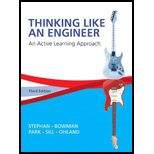
The decay of a radioactive isotope was tracked over a number of hours, resulting in the following data. The decay of a radioactive element is modeled by the following equation, where C0 is the initial amount of the element at time zero, and k is the decay constant of the isotope.
C=C0e-kt
Determine the initial concentration and decay constant of the isotope, including value and units.

Want to see the full answer?
Check out a sample textbook solution
Chapter 12 Solutions
Thinking Like an Engineer: An Active Learning Approach (3rd Edition)
Additional Engineering Textbook Solutions
Java: An Introduction to Problem Solving and Programming (8th Edition)
Modern Database Management
Starting Out with Java: From Control Structures through Objects (7th Edition) (What's New in Computer Science)
Starting Out with Programming Logic and Design (5th Edition) (What's New in Computer Science)
Introduction To Programming Using Visual Basic (11th Edition)
Elementary Surveying: An Introduction To Geomatics (15th Edition)
- 16.144 A uniform bar AB, of weight 30 lb and length 3 ft, is attached to the 40-lb cart C. Neglecting friction, determine immediately after the system is released from rest: a) the acceleration of the cart,b) the angular acceleration of the bar.arrow_forwardI have a machine theory assignment and I am adding the conditions of this assignment here as a picture. You choose the mechanism and write the necessary solutions for this mechanism.arrow_forwardQ41 (20 Marks) An ideal steam power plant works on regenerative cycle. Some steam (y1) is bled out between first and second stage and another portion (y2) is bled between second and third stages and feed the feed water heaters as shown in the following figures. In terms of enthalpies determine (1) y1 (2) y2 (3)the work at the first turbine (4) the work at the second turbine (5) the work at the third turbine (6) the work at the pump (FP1) (7) the work at the pump (FP2) (8) the work at the pump (CEP) (9) the heat received at the boiler (10) the rejected heat Boiler NY ST1 ST2 ST3 TI 52 Condenser CFWH OFWH 11 www 12 10 CEP FP FParrow_forward
- DONT USE ARTIFICIAL INTELLIGENCEarrow_forwardQ2] (20 Marks) A steam turbine with one open feed water heater (OFWH) as shown in the following figure. In terms of enthalpies and y determine: 1- Work of HPT 2- Work of LPT 3- Work at Pump1 4- Work at Pump2 5-The heat added at the boiler 6- The quantity (y) in terms of enthalpies 7-Heat extracted from condenser 5 Boiler 2岁 3 OFWH 9 Pump2 HPT LPT 8 Pump1 O Condenserarrow_forward11.2 Boxes A and B are at rest on a conveyer belt that is initially at rest. The belt suddenly starts in an upward direction so that slipping instantly occurs between the belt and the boxes. The kinetic friction coefficients between the belt and the boxes are μk,A = 0.3 and μk,B = 0.32. Determine the initial acceleration of each box. Will the blocks stay together, or separate? 80 lb 100 lb A B 15° Hint: to see if the boxes stay together or separate, first assume they separate, and see if their resulting motion (acceleration) validates that assumption. If the their motion is not consistent with the assumption of separation, then they must stay together.arrow_forward
- An ideal gas is enclosed in a cylinder which has a movable piston. The gas is heated, resulting in an increase in temperature of the gas, and work is done by the gas on the piston so that the pressure remains constant. a) Is the work done by the gas negative, positive or zero? b) From a microscopic view, how is the internal energy of the gas molecules affected? c) Is the heat less than, greater than or equal to the work? Explain you answer.arrow_forwardI need to adapt a real-life system to this assignment. It doesn't need to be a very complicated system. I am a senior mechanical engineering student. I need help with my mechanical theory homeworkarrow_forwardstate all the formulae associated with adiabatic processarrow_forward
- Design a Moore type synchronous state machine with three external inputs A1, A2, A3 and one output signal F. The output F goes to 1 when A1.A2.-A3 = 1 at the next system timing event. The output F stays at 1 as long as A3=0; otherwise, the output goes to 0. (Note: use a positive edge-triggered D flip-flop in the design) Write a VHDL code to describe the implementation of one-digit decimal counter using PROCESS.arrow_forwardState all the formulae associated with the Isothermal Process.arrow_forward: +0 العنوان solle не Am 4 A pump draws water through a 300-mm diameter cast iron pipe, 15m long from a reservoir in which the water surface is 4.5 m higher than the pump and discharges through a 250- mm diameter cast iron, 75 m long, to an elevated tank in which the water surface is 60 m higher than the pump. Q=0.25 m³/s. Considering f-0.02 and the coefficients for minor head losses (k entrance 0.5, k bend 0.35, and K exit -0.5), compute the power of the pump. ۳/۱ ۲/۱ 4.5 m Kentrance 300 mm dia. 15 m Length 250 mm dia. 75 m Length kpend kexit 60 m ostlararrow_forward
 Principles of Heat Transfer (Activate Learning wi...Mechanical EngineeringISBN:9781305387102Author:Kreith, Frank; Manglik, Raj M.Publisher:Cengage Learning
Principles of Heat Transfer (Activate Learning wi...Mechanical EngineeringISBN:9781305387102Author:Kreith, Frank; Manglik, Raj M.Publisher:Cengage Learning
